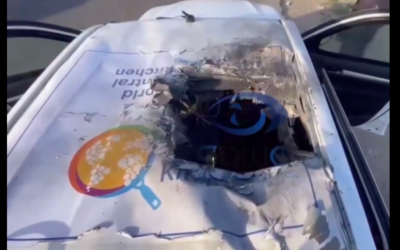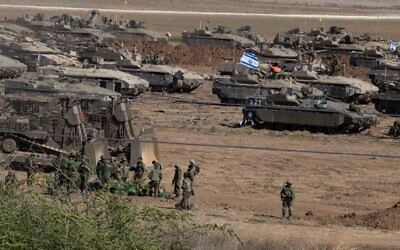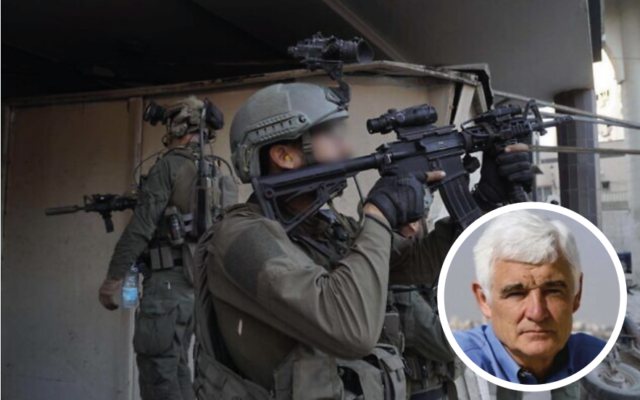OPINION: The IDF’s tragic mistake has damaged the ethical doctrine it values most
Award-winning journalist says army’s inquiry into its unintentional strikes on WCK aid workers has been commendably swift but has also opened a pandora’s box for Israel
Yes, terrible mistakes happen all the time in war. In that sense, the IDF is no different from any other modern army – except that in the IDF’s case its latest mistake has done serious damage to the ethical doctrine it values most.
That doctrine is called ‘purity of arms’ and it is embodied in what the Israel Defence Forces call “the spirit of the IDF”. It obliges the IDF to “do everything in its power to prevent harm” to the lives of both “civilians and prisoners… their lives, bodies, dignity and property”.
Indeed, this code has been repeatedly invoked by Israel in its response to allegations that it is indifferent to scale of civilian deaths in its war against Hamas.
The IDF’s investigation into the mistaken targeting of three World Central Kitchen (WCK) vehicles killing seven aid workers last Monday near Deir al-Balah has been commendably swift. But it has also opened a new pandora’s box for Israel: 196 aid workers – mostly Palestinian – have also died in this conflict. UN secretary general António Guterres now demands Israel explains “why each of them was killed”.
He has a point. The IDF investigation shows the authorisation to fire anti-personnel missiles at three WCK vehicles from a drone was based not on hard evidence but a series of assumptions that its passengers included at least one gunman. A reserve lieutenant colonel and major at the command centre of the Nahal Brigade who authorised the firing have been dismissed. The brigade commander, the divisional commander and the head of Southern Command Major General Yaron Finkelman have all been reprimanded.
Still, it is worth teasing out the details because they vividly illustrate how fatal mistakes are made in the fog of war.
The drone unit’s perilous assumptions have their origin 23 minutes prior to the first strike when a drone operator spotted a gunman atop an aid lorry en route to a warehouse to unload its cargo. He is seen opening fire, it’s thought to keep a crowd back. A second gunman is also seen joining the lorry as it entered the warehouse. One vehicle is later seen leaving the warehouse heading north to a second warehouse where four people exit carrying what the IDF say looked like weapons. Three vehicles are also seen leaving the warehouse and heading south.

The IDF says that no one in the drone unit was aware that those three vehicles were WCK. That’s because it was night and the drone cameras didn’t pick out the WCK logos on the vehicles’ roofs. And, crucially, the drone unit had not been given the details of the WCK vehicles or their movements by those in the IDF with whom this information had been registered – and moreover, registered by WCK precisely in order to prevent the tragedy that was about to unfold.
The IDF says these vital details “stopped somewhere” in the communication chain… “We don’t know where”. Nor do we yet know why the IDF didn’t know where in the chain that vital information was lost.
What is indisputable is that without the drone unit knowing all three vehicles were WCK, they became targets in their eyes. It might be argued that this was a reasonable assumption: they’d seen two gunmen on the aid lorry as it entered the warehouse; a single vehicle was then seen leaving the warehouse heading north with four people exiting that vehicle a short distance away with what looked like guns; three more vehicles then emerged heading south and neither the drone operators nor their senior officers, apparently, had any idea they were with the WCK. To the drone unit and their commanding officers, these events must have looked as if this was another case of Hamas appropriating aid intended for civilians.
Yet no one had actually seen anyone with a confirmed weapon getting into any of the WCK vehicles, just one individual carrying what looked as if it might be a gun, although there couldn’t have been any certainty about that because the images picked up by the drone’s camera were grainy black and white. The IDF now thinks a “bag or something similar” was mistaken for a gun but admit it “doesn’t know” that.

In any case, the drone operators and the two senior officers who authorised the attack appear to have made a further series of assumptions: that the “gunman” had survived the first strike because people were seen running from the stricken vehicle to the second vehicle, so a second strike was authorised on that vehicle. When survivors were again seen escaping from the second vehicle, a third strike was ordered on the third vehicle, again on the assumption that the gunman had miraculously survived both the first and second strikes. Authorising the second and third strikes on the basis of these untested assumptions was “against standard operational procedures” says the IDF.
There is no evidence, however, that the drone unit fired “knowing that it was our teams moving on that road” as WCK’s founder Jose Andres precipitously alleged after the incident. Reporters who were shown the drone footage late on Thursday night have independently confirmed that the WCK logos on the three vehicles were not visible. It would have been a simple matter for the WCK to have used lettering that would have illuminated their logo to the drone’s camera – standard procedure for BBC and news crews in their vehicles in war zones, but this did not happen. The IDF also insist that the drone unit had not been notified of WCK movements by those in the IDF responsible for deconflicting military and aid operations.
None of these facts appear to have prevented an Al Jazeera TV podcast called The Take from its portentous assertion that its own “investigation” had “found that the Israeli military intentionally targeted” the WCK convoy without actually providing any credible evidence that the IDF knew the convoy was WCK. But that’s agenda journalism for you.

Nevertheless, the lethal assumptions made about the series of known unknowns about the WCK convoy raise a bigger question that goes back to statements made by the Israeli defence minister Yoav Gallant three days after the 7 October pogrom.
As the IDF mobilised for a “full offensive” against the Gaza Strip, Gallant announced “I have released all the restraints.”
John Spencer, an ex-infantry soldier and widely considered to be a leading expert on urban warfare at the US Military Academy at West Point, powerfully argues that the Israel Hamas war is without precedent. In terms of the battle space, I know what he means.
When I was in Israel last November, the IDF showed me table sized aerial maps with colour coded dots indicating Hamas and Palestine Islamic Jihad rocket launch positions as of the evening 7 October, by which time Israel and Hamas were officially at war.
Other maps pinpointed weapons storage centres, anti-tank firing positions, and communications centres. Gaza was literally a mass of many thousands of dots – and these were only the targets that were known. Under the laws of armed conflict each dot represented potentially a legitimate military target.
In the Strip’s most densely populated cities, especially in parts of Gaza City, there were often mere metres between these targets and non- combatants in apartment blocks, mosques, schools, offices, clinics, etc. So how to achieve Israel’s war aims of degrading Hamas to the point where it no longer poses a threat to the everyday lives of citizens in southern Israel? Particularly given Hamas’s vow to repeat 7 October “again and again”.
Israel says it has made literally tens of millions of calls, texts, voice messages and airdropped leaflets in its attempt to move Gazan civilians out of harm’s way as it worked its way through destroying the multitude of military targets. Mostly – but not always – it has used precision-guided weapons to minimise civilian deaths. Sometimes these warnings have been inaccurate, sometimes too late, sometimes they don’t appear to have been given at all, and the hardship for Gazans who have so far survived this war from being frequently on the move, has been greater than many of us could bear. But Israel bent on the genocidal destruction of the Palestinian people? The evidence for the opposite seems to me to be so blindingly obvious you have to wonder at the ability to reason of those who insist otherwise.
Has Israel lived up to the noble standard its sets for its armed forces in its ‘purity of arms’ doctrine – to do “everything” in its “power to prevent harm to civilians and prisoners…. their lives, bodies dignity and property”.
It seems to me that Israel too often has fallen well short of that.
In the initial phase of “Swords of Iron”, the “restraints” to which defence minister Gallant referred, appear to have been partially lifted and that overall, the IDF has also been prepared to tolerate a higher civilian death toll in pursuit of the war cabinet’s goals of effectively destroying Hamas’ war machine, than in previous rounds of Israel’s conflict with Hamas.
Data on air strikes alone compiled by the Israeli newspaper Haaretz, show that in the first three weeks of the war, 68 percent of those killed were what can reasonably be described as non-combatants (under 17 year olds, women and men over 60). Attributing 10 percent of those deaths to misfired Palestinian rockets (based on previous Israel-Gaza flare-ups) reduces that non-combatant ratio to 61 percent.
This compares to approximately 37 percent non-combatant deaths in the four preceding campaigns which, like the first three weeks of “Swords of Iron” were exclusively aerial and in total spanned a similar length (25 days): Shield and Arrow (May 2023); Breaking Dawn (August 2022); Guardian of the Walls (May 2021) and Pillar of Defense (November 2012). The data from the latter four aerial campaigns was sourced from the Meir Amit Intelligence and Terrorism Information Center which is closely associated with Israeli intelligence.
As one veteran warrior put it, ‘If you lose your humanity, you are useless as a soldier
In the ground campaign that followed the aerial phase of “Swords of Iron”, there is also compelling evidence that some IDF units have made even more speculative assumptions about unarmed Gazans having terrorist links, than did the IDF drone unit about a convoy of vehicles that turned out to be full of humanitarian aid workers. And that these units have not been pulled back into line.
There have been several filmed incidents of soldiers shooting unarmed Palestinians waving white flags or just surrendering – even after an IDF sniper shot dead three shirtless Israeli hostages waving a white flag last December.
Two brothers aged 13 and 20 shot when the younger brother stepped out of his house with a white flag after the IDF had advised residents to leave for their own safety.
A grandmother fleeing with her grandson who was waving a white flag, shot dead- again for no apparent reason.
Two men shot dead while waving white flags as they tried to return to their homes. Both were in a wide-open space, far from any buildings or people, so it’s hard to see how either man posed a risk to soldiers. One man appears to have been shot after he had asked the soldiers if he could speak to them, and they’d signalled him to approach. The other was shot in the back as he ran away still frantically waving a white flag. The soldiers then used a bulldozer to bury both men in the sand and litter. So much for the IDF’s ‘purity of arms’ stricture about treating casualties with “dignity.” The army is reported to have said the bulldozer was used because the men had carried bags which might have contained explosives. No bags are visible in the footage.
On their face, these incidents would seem to qualify as blatant extra judicial killings. Other soldiers concerned at the IDF’s departure from its ethical code have spoken of combat units writing their own rules of engagement. “Regrettably, there are still commanders, even senior ones, who do as they please in their conduct in the Gaza Strip” a senior defence official is reported as saying. Which is pretty unsmart because it leads to people like 600 British jurists, including three ex Supreme Court judges demanding a ban on arms sales to Israel.
Many social media clips have also been posted by soldiers filming themselves grinning as they vandalise shops, make insulting comments about Palestinians, ransacking abandoned homes (setting fire to one), and flaunting intimate possessions like frilly bras and pants from bedrooms. “I stopped counting how many neighbourhoods I’ve erased,” the caption reads on a video posted to one soldier’s personal TikTok, to the sound of a jaunty song as he enjoys driving a bulldozer down a street in northern Gaza, pushing several battered cars toward a half-collapsed building. The soldiers look pleased with themselves, exuding a confidence that they can do whatever they want.
Yes, this is war, and a particularly terrifying one for those young soldiers who’ve been caught up in the claustrophobic close quarter combat of Gaza’s cities. But letting off steam by advertising this kind of conduct to the world undermines the IDF’s claim that its soldiers are “obligated to protect human dignity.”
The IDF high command has condemned this behaviour as “deplorable” to such an extent that the Chief of Staff Major General Herzi Halevi felt compelled to issue this communique to his soldiers: “We are not on a killing spree, revenge or genocide. We have come to win and defeat a cruel enemy who deserves a bitter loss.” He also urged them “not to use force where it’s not required, take anything that isn’t ours, or film revenge videos.”
Yet reports of poor discipline and field commanders making up their own rules continue to appear in the Israeli media. It may be a minority of soldiers but there have been too many questionable incidents to suggest it’s a tiny minority. And this matters – not just now – but especially if this war ever moves to a post conflict reconstruction phase as inevitably it must. “Decisions about when and when not to pull the trigger become all the more important once the main fighting is over” observes Raphael Cohen, a political scientist at the authorative Rand Corporation. “A single incident can upend months of stabilisation efforts.”
Israel’s closest allies want it to fight more like the Americans and British did in Iraq, but given Israel’s history and especially Hamas’s authentic genocidal intent, Israel views its war as existential – a “society-wide struggle more akin to World War II than the Iraq War, which was a war of choice” as Cohen puts it. The IDF is also a mix of elite professionalism, less professional reservists and young conscripts. Perhaps we are merely witnessing the perils of a citizen army. But whatever the explanation, too many soldiers in all ranks seem serenely oblivious to the fact that IDF has a higher duty to the Jewish state’s moral reputation than to their own sense of vengeance – however understandable post 7 October that may be. Or, as one veteran warrior put it “succumbing to the weakness of killing just because you can. If you lose your humanity, you are useless as a soldier.”
The IDF High Command still has a job of work to do to put into practice the values its estimable ethical code so correctly preaches – across all ranks.

Thank you for helping to make Jewish News the leading source of news and opinion for the UK Jewish community. Today we're asking for your invaluable help to continue putting our community first in everything we do.
For as little as £5 a month you can help sustain the vital work we do in celebrating and standing up for Jewish life in Britain.
Jewish News holds our community together and keeps us connected. Like a synagogue, it’s where people turn to feel part of something bigger. It also proudly shows the rest of Britain the vibrancy and rich culture of modern Jewish life.
You can make a quick and easy one-off or monthly contribution of £5, £10, £20 or any other sum you’re comfortable with.
100% of your donation will help us continue celebrating our community, in all its dynamic diversity...
Engaging
Being a community platform means so much more than producing a newspaper and website. One of our proudest roles is media partnering with our invaluable charities to amplify the outstanding work they do to help us all.
Celebrating
There’s no shortage of oys in the world but Jewish News takes every opportunity to celebrate the joys too, through projects like Night of Heroes, 40 Under 40 and other compelling countdowns that make the community kvell with pride.
Pioneering
In the first collaboration between media outlets from different faiths, Jewish News worked with British Muslim TV and Church Times to produce a list of young activists leading the way on interfaith understanding.
Campaigning
Royal Mail issued a stamp honouring Holocaust hero Sir Nicholas Winton after a Jewish News campaign attracted more than 100,000 backers. Jewish Newsalso produces special editions of the paper highlighting pressing issues including mental health and Holocaust remembrance.
Easy access
In an age when news is readily accessible, Jewish News provides high-quality content free online and offline, removing any financial barriers to connecting people.
Voice of our community to wider society
The Jewish News team regularly appears on TV, radio and on the pages of the national press to comment on stories about the Jewish community. Easy access to the paper on the streets of London also means Jewish News provides an invaluable window into the community for the country at large.
We hope you agree all this is worth preserving.






















